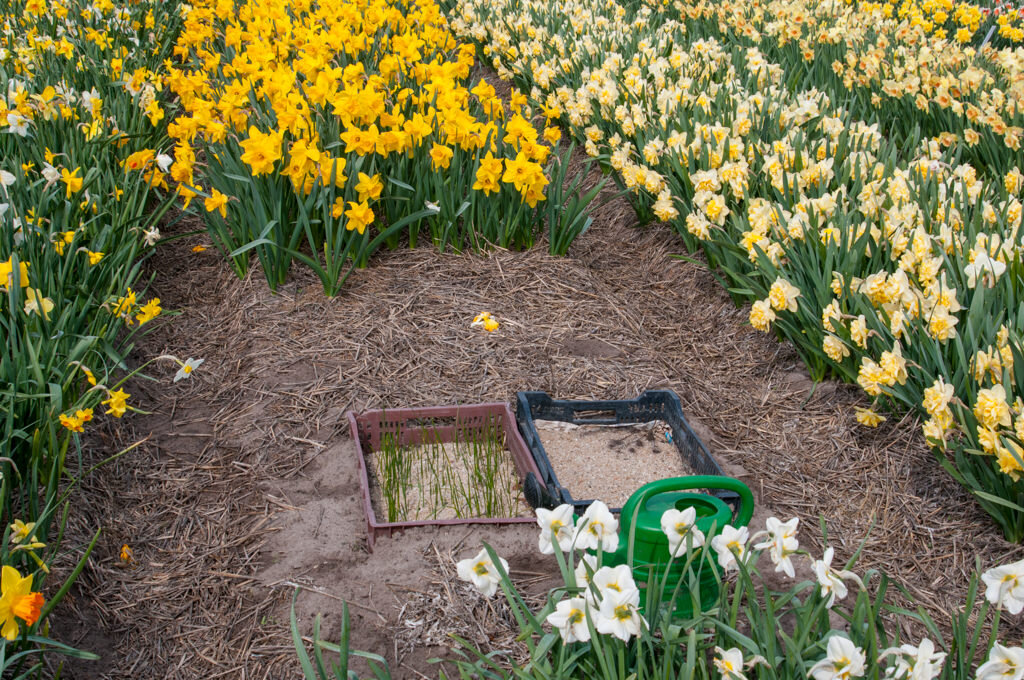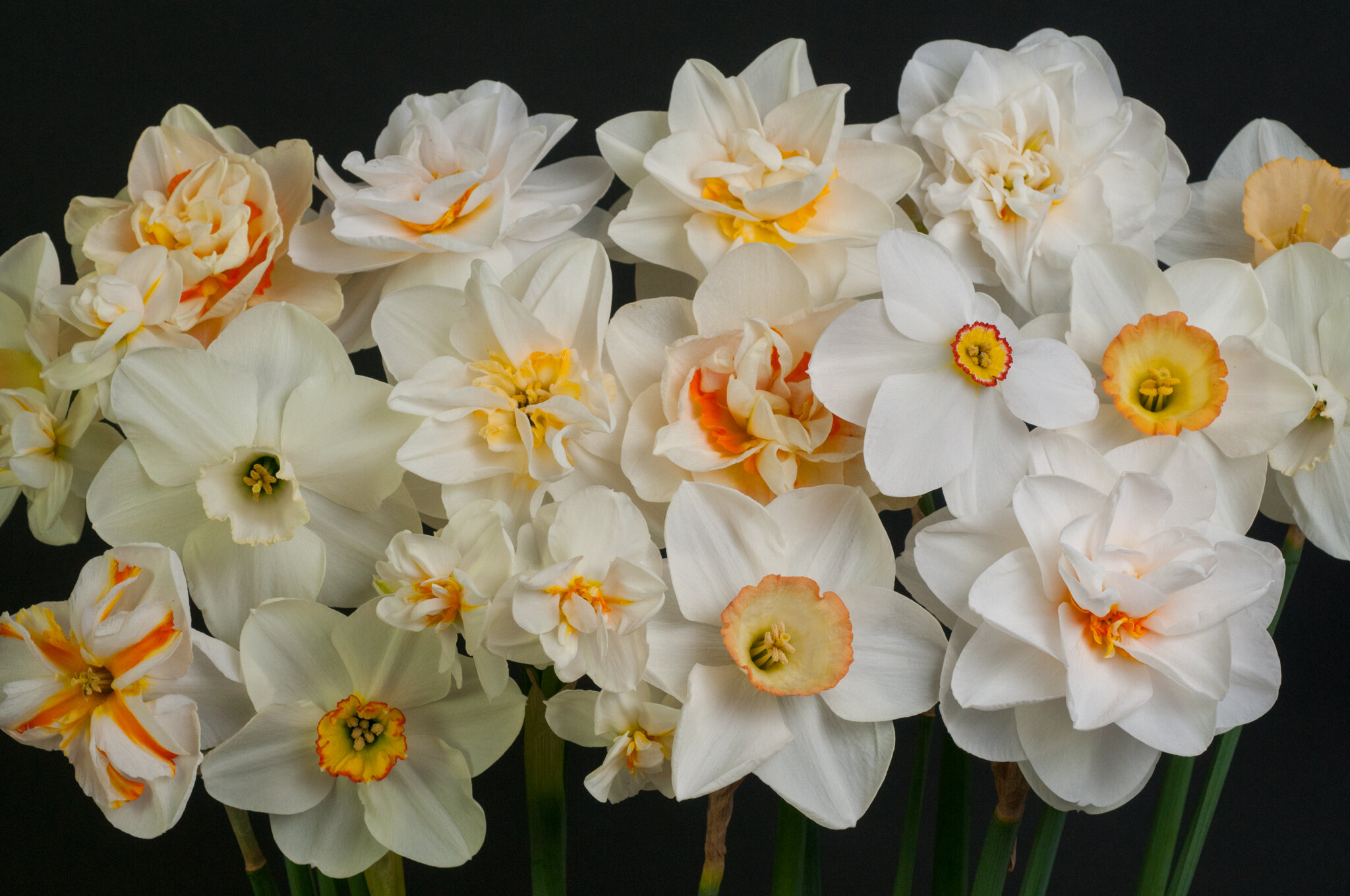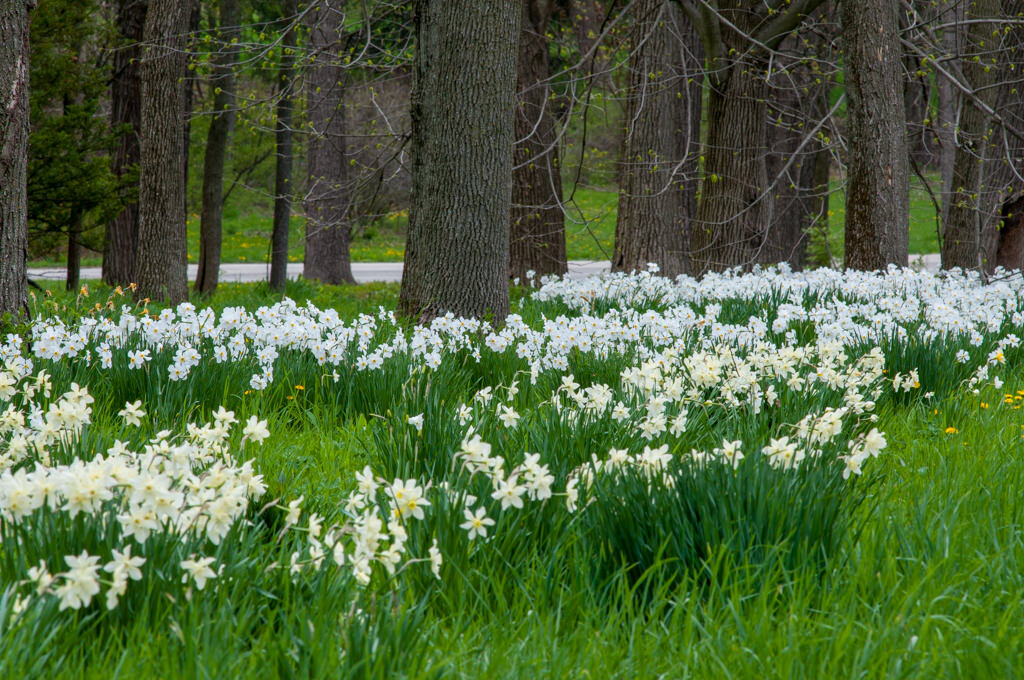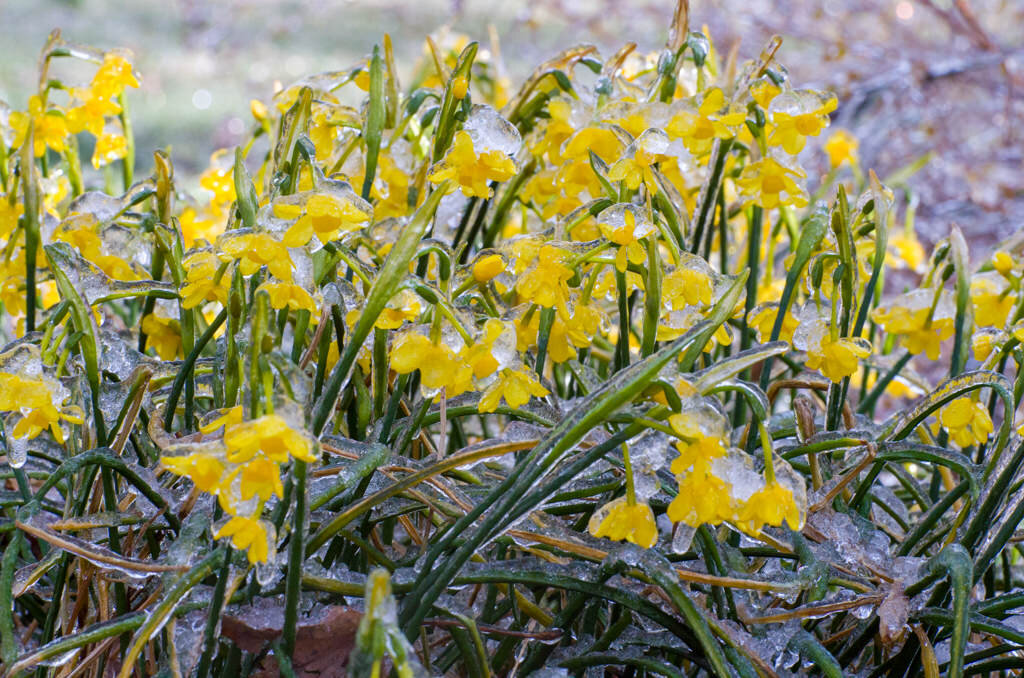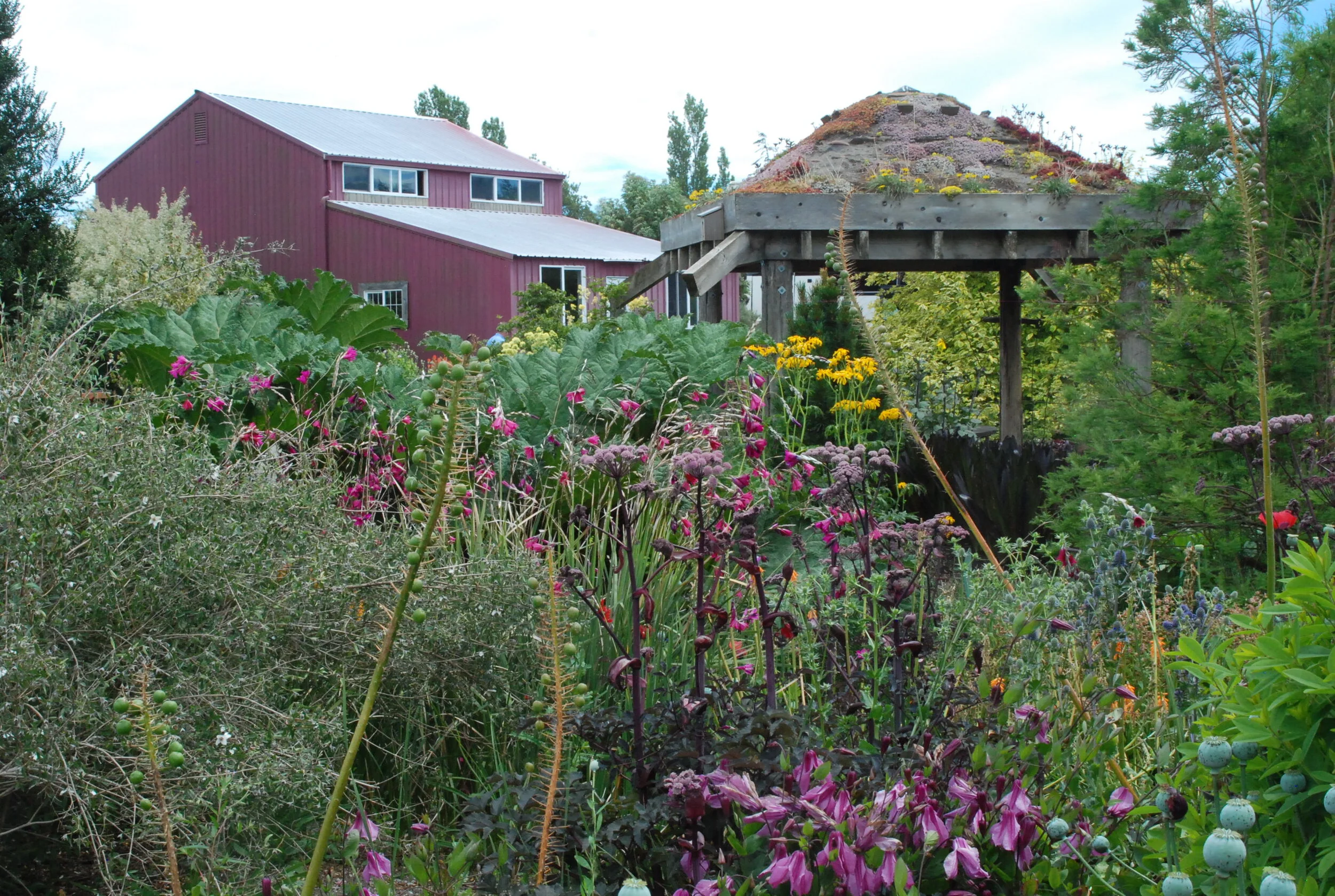Specialty Nursery Profile: Q Daffs
The interviewee, Christopher Harley, kneels down to capture the daffodils at their best in the production fields.
Carlos van der Veek taking pics of the view from the wind turbine. The daffodil nursery is visible at the lower left. It is dwarfed by a single variety of tulips across the street. This is polder land, you can see how it lies below the North Sea.
Interview by Eric Hsu, Christopher Harley and Carlos van der Veek of Q Daffs
Photography by Christopher Harley and Carlos van der Veek
I’ve always loved daffodils - there’s something uplifting and cheerful about the way their trumpets bob forth in the spring breezes, and their bright yellow and white colors radiate optimism against the blue skies. My first daffodil was ‘Fortune’, a bright yellow with an orange trumpet, that I bought as a bag of five from the local garden center. Unlike the tulips that withered away over the years, those five bulbs multiplied into ten, fifteen. It wasn’t until later my love for daffodils took hold after spending time to identify the mystery ones at work - I was becoming drawn to the older, starry or looser types that were hard to find in the trade. Q Daffs (www.qdaffs.us), which launched last year, stepped in to broaden the choices, after the last few years of depending on other smaller scale producers whose availability lists changed every year. Sensing a demand for hard-to-find daffodils, Christopher Farley and Carlos van der Veek banded together to import them to the US market. We gardeners count ourselves so lucky!
Every plant obsession has to start somewhere – a match lit ignites a conflagration. How did you become interested in daffodils?
My parents, originally from Indiana and Ohio, always gardened, vegetables and ornamentals. They had very few bulbs. Too expensive, no free seeds, no free cuttings. My mother did some garden writing along with science fiction, aerospace and textbooks.
The first time I helped out in the warehouse on computer systems they paid me in bulbs: ‘Tete a tete’, ‘Barret Browning’ and ‘Actaea’ I think. That was 25 years ago. Since then I have been fortunate to work in spring flowering bulbs, meeting and working with many knowledgeable growers, breeders, designers and gardeners. And collected a lot of nice narcissus along the way.
We live on a kind of agri-tainment street, my neighbors have beautiful and very old working farms and nurseries. I’ve worked with them over the years, so we have many varieties planted around town. We added a lot of historic daffodils last November.
As you know, growing a plant makes you come to appreciate its good and bad traits, and often leads to an inseparable friendship. Working with Carlos over the years I came to believe that this level of daffodil involvement was normal.
Tulips are the money-makers in the trade. They are lovely and varied. And my lust for tulips is larger than the property, the deer fencing and the wallet. But for the practical gardener daffodils are of a happier nature, quite independent and most loyal in the long game. Narcissus is a genus more than most of profound depth, intrigue and versatility.
My happy moment came when the cashier at the local Agway called up to the office and said “It’s for the guy from the daffodil house.”
Bud McQuade’s (rip) perennialized Daffodil planting, dominated by ‘Sir Watkin’ and ‘Queen of the North’ in Redding, Connecticut.
Gardeners have seen wider access to cut flowers and edible plants, especially vegetables and fruits, although ornamental plants, outside of houseplants, have been slow to ride the crest. Daffodils seem primed to be more popular (they are tough, deer and rodent-resistant, and ask for little in return), but the niche for selling the public on different ones is still open. How did the business venture for Q Daffs come about?
I stepped back from day to day operations at Colorblends last year and had time for some more wide-ranging projects. Carlos van de Veek is of course interested in keeping the nursery viable and producing. His collection has tremendous depth in miniature, historic and novel varieties. Some members of the American Daffodil Society approached Carlos in Texas asking if there was any way to get availability on his varieties in America. So together, with my experience in eCommerce and the US market, we agreed to give QDaffs a try last April. It is a bit freeing to be able to offer so many useful and sturdy daffodils that are outside the commercial trade.
We had tried at Colorblends, in 2006 I think, to market specialty daffodils through the “Daffodil Depot” brand but it didn’t prove sustainable at that time.
As QDaffs, we are casting a wider net to attract both established gardeners and the new class of quarantined gardeners. People with established borders are often happy to get the smaller quantities we offer, and the ability to try out new things without a big commitment of 25 or 100 of a single cultivar. But the jury is still out.
Getting people new to bulbs to understand that they are an autumn activity is the highest hurdle. Because there is not always an overlap between the tulip people and daffodil people, I always try to encourage beginners to scale back that overly ecstatic tulip budget and allocate some for daffodils.
A helpful marketing professional asked how we would describe our product line. Our reply was “We sell a plant that is non-native, toxic, ornamental, manually processed, requires a shovel, grows like a weed and serves almost no practical purpose. But when it comes up in the spring everyone is sold.”
Daffodil seedlings resemble grass shoots when compared against their mature flowering brethren.
How long does it take for a promising daffodil seedling to reach commercial viability?
Six years to get to a seedling and then another six or so for a breeder to build up stocks and find a grower, who will in turn grow it for a year or two and then start to market it to commercial buyers and exporters. In the Netherlands there is an elaborate co-op system which helps with the contracts, sales and marketing.
Even a sport, which bypasses the cross and selection process must be grown out for a few years to determine its stability.
A grower is always evaluating their list of cultivars. It is not an uncommon site in the Spring in the Netherlands to see grower’s families walking the trial varieties and seedlings after dinner deciding together which will survive and which will get the heave-ho. In the end it is about pulling the maximum value from the family acreage.
Sometimes, after a few years, it becomes apparent that a promising variety is not an increaser, or not disease resistant. I remember asking a breeder “What happened to ‘MegaWatt’?”, a very impressive 4 W-W seedling. The answer was “ ‘MegaWatt’ had a meltdown and had to be destroyed.”.
‘Rosemoor Gold’ now scarce in the trade not because of its quality, but its competition with other successful cultivars.
Or it may be a cultivar that competes directly with an established very successful variety. ‘Rosemoor Gold’ was a very good daffodil but had to compete head on with Quail and is now hard to find.
Can you reveal how daffodils are propagated or scaled up to produce large quantities for sale?
As you know most daffodils are bred by hobbyists and individuals on their own dime. Most narcissus growers seem to have a breeding program going on behind the house.
By definition, whether a seedling or sport, every new cultivar starts with a single candidate. So after growing out the seeds and making a selection, by the cold fact of post-Darwinism and capitalism, it will be twin scaled or it will perish. Twin scaling increases stocks very rapidly. When the stock hits a certain mass it can put out enough offsets to cruise along in production numbers without the knife. Sometimes too much so.
Growers can also twin scale production daffodils because it makes a smaller, more manageable bulb. But this has perils. Some of my American friends blame Narcissus virus on twin scaling. And they have a point. But aphids and nematodes are also disease vectors world round. Unlike tulips and lilies, where a virus is an existential threat, it takes more than one or two viruses to bring down a daffodil. It would be malpractice and counter productive to knowingly twin scale an infected stock.
Most viruses can’t make it into the seed, so new seedlings are a way to keep the genus cleaned and ahead of the germs. Dutch growers are always walking the rows and can spot viruses even at dusk. If a stock needs to be cleaned they will take the time to clean it or discard it.
Not all white varieties, and no trumpets, but side by side comparison shows the wide range of whites. Huntington, Connecticut
‘Slim Whitman’, a sport of ‘Ice Follies’ ( we do not list, he’s just an old friend) Huntington, Connecticut.
White daffodils do not appear to persist as long as the yellow ones, and it may account for ‘Actaea’, ‘Ice Follies’, ‘Mount Hood’, and ‘Thalia’ being the top headliners for white cultivars. Are there any promising newcomers that can seize the throne from these stalwarts?
‘Ice Follies’ belongs in a class of its own. Its numbers are falling but still substantial. I suspect that its low price and heavy bulbs makes it less appealing to growers. It is grown in some out of the way places. As much as we enjoy disdain for ‘Ice Follies’, it can be perfect and stunning. Particularly in the South. Sotto voce, I am hoping for ‘Slim Whitman’, a sport of ‘Ice Follies’, to make a comeback. He possesses the same harmony but no pretensions as being all-white.
A few growers have picked ‘Watch Up’ as a replacement for ‘Mount Hood’. It is fragrant and a brighter white than ‘Mount Hood’. I have grown it for about five years and it seems to be increasing in the garden. There are persistent rumors about the decline of ‘Mount Hood’ in commerce, but I checked the numbers and the acreage is actually on the upswing.
‘The Expert’, Huntington, Connecticut
Carlos has some very nice white trumpet seedlings that we are trialing here in Connecticut: ‘La Delicatesse’, ‘The Expert’ and ‘I Love You’. We are all in for ‘The Expert.’
His father’s ‘Snowboard’ is a white large cup who is a very nice garden, pot and show flower. Year-four planted out for us on ‘Snowboard’. Even if you do not love it, the board-dude has four or five superior features making it a good white for comparison and reference. A show-winner.
Narcissus ‘Misty Glen’
‘Misty Glen’, although a duskier white large cup, is very perennial for us here, about a decade. A bit shade tolerant. Having a rough ride recently in the trade, we are listing it this year. It catches the afternoon spring light well.
********
‘Loth Lorien’ is a white and yellow small cup with a green eye that is a very strong grower. It was recently grown in large quantities by several growers but couldn’t find its market.
********
Like ‘Thalia’, I think that you are safe year over year with most triandrus, white or yellow. ‘Collette’ (sp), ‘Ice Wings‘ or ‘Starlight Sensation’, which is fragrant white from Carlos’ father, are all good longevity candidates. There is also ‘Tresamble’, on sabbatical this year, which makes a large bulb - we planted it out in great numbers in Connecticut for cut flowers.
I do not have any experience with ‘Petrel’ in the garden, but it is a most beautiful white triandrus. Along with ‘Ringing Bells’, they are Grant Mitsch seedlings which makes me believe they have been pre-evaluated for longevity.
I am coming to the conclusion that Triandrus are super growers and super breeders. What they lack in fragrance they make up in vigor.
****
And white doubles. . We aren’t really listing many 4 W-Ws this year, but in the garden varieties more mainstream bloomers like ‘Acropolis’, ‘Obdam’, ‘White Lion’, ‘White Medal’ seem to persist well. We have an assortment of white doubles in the way back bed for so long that the tags are gone. ‘Gay Challenger’, which I don’t think you can find anymore, is to my eye the very best white colored flower of all. The biggest troubles with doubles are wimpy stems. Even the ragged blooms have a best-in-class radial symmetry thing going on.
‘Actaea’ flowering with other historic varieties at the Morton Arboretum, Lisle, Illinois.
‘Actaea’ is the poet that did not spit out the bit. And still riding at a full gallop wherever it has been planted.
‘Queen of the North’ is one tough bright-faced lady.
‘Snipe’ on site for a decade. Huntington, Connecticut
‘W.P. Milner’ at Chanticleer
‘Alec Gray’, a miniature named after a breeder who specialized in breeding them.
Daffodil fanciers have taken to breeding miniature or petite cultivars, some of which fit well with cyclamen, snowdrops, and anemones. Moreover, their foliage disappears neatly unlike their larger cousins! Would you like to single out the ones that are adaptable and less fickle about conditions?
You make a very good point. Miniature daffodils and Bulbocodium should be marketed along with other early spring ephemerals: Galanthus, Eranthis, Crocus. A clump of eight miniature daffodils makes a real statement. But a planting of six or eight large daffodils like ‘Red Devon’ or ‘Damson’ strewn in the landscape is a sparse and sad affair.
10 days later these Narcissus jonquilla var. henriquesii. were even better. Huntington, Connecticut
If you are interested in miniatures then consider all species for your list. They are ageless and adaptable. The species jonquilla, such as henriquesii, are well established for us in 6A-B, but many jonquilla cultivars come and go earlier than we would like. With a wide southern range, they act like they own the place.
‘W.P. Milner’ is an intermediate, not a miniature, but is a terrific cultivar for anyone looking for compact interest and ease of growing. Takes a licking and plays well with others. A very old and inexpensive daffodil with a statuesque pseudonarcissus form that is not prevalent in miniatures. (Excepting Pledge)
Miniature trial bed, Huntington, Connecticut 10/19/2020.
‘Segovia’ and ‘Sundisc’ are dependable, tops and tough and ever oh so cute. Snipe is a sassy long gamer and a pendant cyclamineus that appears to be immortal. One of our dearest family friends, one of the very best. Obvallaris can be tough and primordial. But these are older varieties
‘More and More’, ‘Miss Klein’ and ‘Medway Gold’ are newer miniature jonquils that we are keeping an eye on. There are so many nice jonquillas that wink at you and smell good, but for us in New England they do not increase. In 7a-8b jonquils will grow freely. Everyone is happy to have jonquils in the spring.
Long blooming and charming, Bulbocodium are under-used and unfamiliar to many. Breeding has picked up recently and now there are a few cultivars, along with species, to pick from. They bloom in the snow; the jury is still out as to their northern range. In the South they are fantastically feral.
We planted trial beds of about 60 miniatures here last fall. So we still have a lot to learn.
Fragrance is one pleasant trait of daffodils – although the aroma of paperwhites can be too overpowering for some noses. Just as some rose breeders are trying to re-introduce scent, have there been targeted efforts to select for scent in daffodils?
This is a good question, I will need to ask around if anyone is pursuing this.
Very few callers are calling the 800 number about fragrance, and half of those are just plain against smelly stuff. But fragrance is at best a lagniappe in commerce. It gets mentioned, but you can’t Instagram it or charge a premium for it.
I don’t believe that scent in Narcissus has been diminished by breeding. It seems persistent in the descendants of jonquils, tazettas, poets. But it also pops up in surprising places.
Separately paperwhite breeder seem to be pursuing de-fragrance. Whatever. Can you name a smell-free tazetta?
There is a recent introduction from Carlos’ father ‘Sweet Ocean’, a floriferous double, that is a bed-headed and bright, gloriously fragrant thing.
There are a few other sensual pleasures in life that compete with walking into a warehouse, garden, flower shop or show floor and getting a waft of that springtime daffodil goodness.
Every Spring we say “I forgot how good this one smells”.
Over the last decade, the list of daffodil cultivars available for sale seem to have decreased rather than increased. Would you like to pinpoint what are the reasons behind this decline in diversity of cultivars?
Carlos answered “ This is something you see in the whole agricultural industry. Fewer companies are producing a much larger quantity of product. Everything has to be done on a larger scale with lower costs. So growers are upscaling their acreage but at the same time downscaling their number of varieties.
To find something special you have to try harder nowadays but luckily there still are a few specialty shops still offering varieties out of the ordinary.”
Part of it is the physical shape of the genus. Tulips, lilies, hyacinths and crocus are all round, somewhat symmetrical, and easily graded at flowering size. They are easier to wash, inspect, grade, sort and count because they drop through those round little holes without a catch. The majority of tulips and lilies are going to be forced for cut flowers in greenhouses just miles away from the growers’ fields – those bulbs need hardly any handling at all. This is the ecosystem that daffodil production in the NL co-exists with.
Daffodils have all those noses, roots and necks sticking out this way and that, and vary in shape and size even within the same cultivar. They can be vulnerable to damage and fungus where the slabs (offsets) meet the basal plate. Physical damage to the basal plate limits root growth.
Narcissus bulbs are heavy. They need to lose a lot of water weight sunbathing before they can be shipped. For export to the US they must be completely free of soil, think of all of those nooks and crannies. If it were possible to grow only rounds (single-nosed daffodils) then there would be fewer headaches for the growers and the shippers. Not so good for us, the customer.
Qdaffs is not highly mechanized - we are hand sorting, counting and packing the bulbs. We are pulling varieties not from commercial farms but from the collection that Carlos’ father started with bulbs given him by retiring growers long ago, along with his seedlings.
Five nosed bulb of ‘Medway Gold’ fully intact after the transatlantic crossing. 8 grams.
Bulb.of ‘Music Hall’, 100 grams.
We have taken to weighing and recording the cultivars, as received here in the US, as a way to have some baseline data as to the difference in sizes between them. ‘Snipe’ is featherweight at 6 grams, up to ‘Star Glow’ at a whopping 180 grams. A lot of the historics make bulbs consistently in the 150 grams range. A 12cm+ tulip bulb weighs 35 grams. So you easily arrive at the situation where 100 or 200 daffodils fill the same crate that holds 300 lilies or 600 tulips. Another disincentive for the grower - Daffodils take up more space for less money.
There is consolidation in the industry, and several very fine growers have exited daffodils altogether. But I can think of several younger, very talented growers with very nice varieties.
From the catbird seat it appears there is a stronger market for daffodils in the US market in the last three years, both in commercial and residential plantings. For the value derived from planting daffodils in the landscape we think they are under used.
In your experiences dealing with Dutch growers and their markets, have you or Carlos noticed different preferences in daffodils in different countries (i.e. Japan, Germany, US)?
Carlos answered “Not really, the only one with his own identity is the US market. I’m sorry to say but for the Americans… bigger is better.
Great Britain might be a little more interested in the smaller and miniature daffodils but there is serious interest in this type in other countries as well.
And yes, pink can be trendy in Japan while the American market fancies red and yellows but quite often this is the other way around after a decade or so. Fashion changes everywhere.”
The number and scale of public and private gardens in America is almost beyond comprehension. Every day a new discovery.
The English on Scilly and the Australians in Canberra have a whole tazzetta subculture going on.
What is your desert island daffodil?
Carlos: ‘Lady Madonna’. (not listed)
Harley: A species jonquilla. ‘Queen of the North’ if I am banished to an archipelago.
Narcissus ‘Queen of the North’






